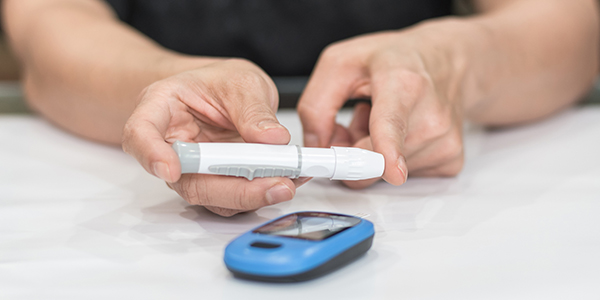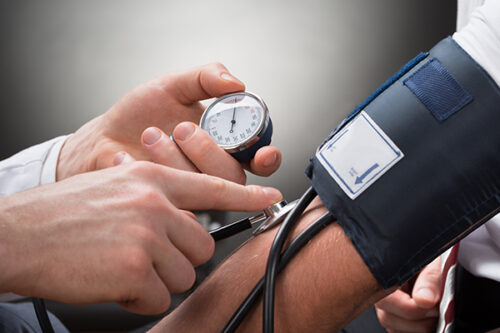Simple Care for Diabetes
Updated October 11, 2021
If you need more support to reverse type 2 diabetes, learn more about our 12-Day McDougall Program.

By John McDougall, MD
Imagine sitting across from your doctor and being told your blood sugar is elevated and that you now have type 2 diabetes. Next you are informed that this condition is in part due to your excess body fat and that if you lose weight your diabetes will improve and possibly go away; however, in the meantime, you need to take medication. The doctor prescribes a diabetic pill (say a sulfonylurea) and hands you a sheet of paper describing a calorie-restricted diet; which incidentally was provided by a drug company representative selling diabetic pills to your doctor. On your first follow-up visit, the next month, despite all of your best efforts, you have gained 4 pounds. Because of your weight gain your blood sugars are still no better in spite of the medication. Your doctor doubles his efforts and adds another medication with a stern warning to lose the weight. The next month your weight is up another 4 pounds. Your blood sugars are now over 200 mg/dL and insulin shots are prescribed. This downhill spiral continues and after one full year of intensive treatment you have now gained 20 pounds of weight, a bag full of pills, bottles, and syringes, and worse health. Nearly every patient gets the same results because the medications do nothing to fix the illness and they compound the patient’s problems by raising the levels of insulin in his or her body — One important effect of insulin is to facilitate the storage of dietary fat into fat cells.
The first step to turning around these events is to stop, or at least drastically reduce, the medications. By removal of the medication-induced “hyper-insulin-state,” the body can now begin making overdue corrections; an important one being weight loss. The second crucial step is to change to a low-fat, animal-food-free, starch-based diet. Starchy foods (rice, corn, potatoes, beans, etc. cause the body’s own insulin to become more powerful; insulin sensitivity is increased.1-3 To further make the point about the benefits of carbohydrates on the function of insulin; even pure simple sugar improves insulin sensitivity.4 A classic experiment on people found an improvement in diabetic control as measured by fasting blood sugar levels, insulin levels, and glucose tolerance tests when diabetics were fed an extreme diet consisting of 85% of the calories as simple sugar (glucose and maltose).4 Animal proteins, like milk casein, and animal fats and vegetable oils reduce the sensitivity of insulin.5,6 The third step is to start exercising which further lowers blood sugars and enhances the weight loss. With these changes a simple cure is possible for essentially everyone with type 2 diabetes.
Diabetes: From Insulin Deficiency to Excess
Diabetes (mellitus) is a disease characterized primarily by elevated sugar levels measured by a blood test usually taken after 6 to 8 hours without food (a fast). Normal fasting blood sugar values vary among healthy people between 50 mg/dL to 100 mg/dL.* Levels above 100 mg/dL suggest impairment of the body’s blood sugar-regulating mechanisms (impaired glucose tolerance = IGT) and a level above 126 mg/dL is defined as diabetes. Blood sugar levels change rapidly, especially after eating (they go up) and after exercise (they go down). Hemoglobin A1c is a common blood test that reflects the average blood sugar over the previous 2 to 3 months and is the gold standard for judging long-term control with medication. It is not a test for diagnosing diabetes. A normal level is considered below 6%. Some patients with diabetes run percentages twice that high.
*Divide mg/dL by 18 for a rough conversion to mmol/L.
Consider diabetes as a spectrum of disease from insulin deficiency (type 1 diabetes) to insulin sufficiency (type-2 diabetes). Insulin is a hormone produced by the beta cells of the pancreas. This vital hormone facilitates the passage of glucose through the cell wall into the cytoplasm where this sugar provides for energy for the body. Insulin also makes possible the storage of dietary fat inside of the fat cells. Insulin production can be permanently reduced by the destruction of the beta cells; this is usually due to an autoimmune reaction (the body attacks itself). Type 1 diabetes follows substantial loss of pancreatic function. Cow’s milk protein is the most common cause of immune-mediated beta cell destruction.7 Type 1 diabetes can occur at any age, even into adulthood. Substantial lack of insulin production is life threatening; the only partial remedy is supplementation with daily insulin injections. The damage is irreversible.
In type 2 diabetes the pancreas is synthesizing normal and sometimes excess amounts of insulin.8,9 However, in this case the problem is not with the pancreas; the problem is that the cells throughout the body have become resistant to the actions of insulin. This peripheral resistance results in less sugar entering the cells and more remaining in the blood. The development of insulin resistance is a normal adaptive mechanism the body uses to ward off extreme fat accumulation when faced with the rich Western diet. Type 2 diabetes is known as non-insulin-dependent diabetes, meaning there is plenty of insulin being synthesized. Therefore, eliminating the resistance to the action of the body’s insulin always cures type-2 diabetes (unless there is in addition some significant loss of beta cell function). This cure is accomplished with substantial weight loss.10 The most healthful and long-lasting way to correct obesity and insulin resistance is by following a high-carbohydrate, low-fat, starch-based diet.10-13
People with Insulin Deficiency May Need Insulin Injections
Those patients requiring insulin can be divided into two categories:
1) Total Insulin Deficiency: The most severe form of insulin deficiency, seen in the classic patient with type 1 diabetes, requires daily insulin supplementation, otherwise the patient will become severely ill (ketoacidosis), and often die without this vital replacement.
2) Trim People with Partial Insulin Deficiency: Most people with blood sugars above 126 mg/dL, who are also trim (not overweight or underweight) fall into the category of partial insulin deficiency. Doctors often refer to this as type 1.5 diabetes. These patients produce enough insulin to avoid life-threatening illness, but not enough to keep their blood sugars normal. With the elevated sugar levels they may also develop adverse effects, such as excessive thirst and urination, and too much weight loss. Insulin injections easily remedy these undesirable conditions.
Treating Type 2 Diabetes in the Overweight Patient
The typical patient I see with a diagnosis of type 2 diabetes is overweight or obese and on a multitude of medications intended to lower their blood sugar. Yet their sugars remain elevated in the 200 mg/dL to 400 mg/dL range; even with their doctors’ best efforts. No matter how often the blood sugar is checked daily, or the amount and kind of medication given, the blood sugars are never normal; they are usually way too high, and on occasion, dangerously low, causing confusion and coma. Obviously, even in the best professional hands, the treatments do not work.
The first step I take is to stop all of their oral medications on the first visit. I do this because these medications have serious adverse effects and no real health benefits. (Yes, they do cause the numbers – sugar and HgBA1c – to look better.) After I explain the facts to the patient, most of them readily agree to make this change.
Diabetic Pills Kill
Most physicians believe that better control of blood sugars means better long-term outcomes for the patients and they enthusiastically prescribed these medications. Research proves otherwise. Diabetic medications are approved by the FDA for market based upon their ability to lower blood sugar levels, not based on any improvements in the quality or quantity of the patients’ lives.
In a major study, a popular diabetic medication, Avandia (rosiglitazone), given at a dosage of 4 mg twice daily, on average, decreased hemoglobin A1c levels by 1.5 percentage points, reduced fasting plasma sugar by 76 mg/dL (4.22 mmol/L), and reduced insulin resistance by 25%.14 These improved numbers should have meant healthier patients, but they didn’t. On May 21, 2007 the New York Times reported, patients taking Avandia had 66 percent more heart attacks, 39 percent more strokes and 20 percent more deaths from cardiovascular-related problems.15,16 Since 1972, the Physicians Desk Reference (PDR) descriptions of most diabetic pills have included two paragraphs in bold print that begin with: Special Warning on Increased Risk of Cardiovascular Mortality. This warning is given because a very commonly prescribed class of oral medication, called sulfonylureas, increases the risk of cardiovascular death by 2 ½ times compared to diet treatment alone.
Reducing Insulin Injections
For the overweight patient, with a diagnosis of type 2 diabetes, significantly elevated blood sugars, and taking insulin, I always reduce their dosage, and most times I ask them to stop the insulin altogether. My decision is based upon my best guess and the patient’s wishes. Many patients are understandably afraid to stop their insulin, so a reduction in dosage is often the best compromise, say stopping all of the short-acting insulin and continuing only the long-acting, or cutting the amount of both the long and short acting in half. This is very safe to do (under doctor’s supervision) for those with type 2 diabetes. The greatest risk to the patient is hypoglycemia from them still taking too much insulin, especially after they change to a low-fat, starch-based diet and start exercising. In almost all cases it is better to guess on the side of less rather than more medication.
At the same time medication changes are being made, my patients begin strictly following the McDougall Diet and exercising daily (slowly at first). I ask them to monitor their blood sugars (fasting) every morning with their home measuring unit and report the results to me daily. Based on these blood sugar numbers their insulin injection dosage is either raised or lowered for that evening or the next day. The goal is to keep their fasting blood sugars between 150 mg/dL and 300 mg/dL. I discourage blood sugar measurements at any other time of the day unless they suspect hypoglycemia (too low a sugar). The finding of elevated sugars later in the day after eating just upsets the patient and does not add any useful information in deciding on the next dosage of insulin to be given.
One other important change I also make is to switch them from multiple shots daily to a single dose of long-acting insulin, such as Lantus, taken once in the evening. (Other long-acting options are Ultralente and Levemir.) A typical starting dose for people with blood sugars between 200 mg/dL and 400 mg/dl is 20 to 40 units of Lantus daily (roughly 10 units of insulin for each 10 mg/dL elevation over 200 mg/dL). The reason I do not try to more aggressively treat the blood sugar numbers to make them look more normal by using more testing, pills, and injections is because this commonly used approach is proven beyond any doubt to harm patients.
For type 2 diabetes I do not prescribe pills; however, when needed, I use long-acting insulin in order to:
1) Decrease the rate of weight loss or to cause weight gain.
2) Relieve symptoms of diabetes, such as excessive thirst and urination.
3) Help relieve the worries of the patient over the high sugar numbers. Being treated with a little insulin makes people feel that all the bases are being covered, especially if their blood sugar numbers look a little lower after the insulin. However, there are possible downsides: Introduction of insulin treatment may cause the patient to become less compliant with their diet and exercising; turning their faith back to the medications, in spite of the facts. Plus, I worry about the harms caused by the medications as I have discussed.
Aggressive Treatment Harms Patients
All six major studies published over the past thirteen years show that attempts by physicians to make the patients’ blood sugars and Hemoglobin A1c levels look more “normal” with medications harm the patients. Three major studies published between 1996 and 2000 found more weight gain, higher cholesterol, triglycerides and/or blood pressure; and more heart disease, stroke and/or death with “aggressive” treatment compared to less treatment.17-19 In 2008, three landmark studies, ACCORD, ADVANCE and VADT, were published in the New England Journal of Medicine.20-22 All three showed aggressive treatment does more harm than good. On February 6, 2008 the National Heart, Lung, and Blood Institute (NHLBI), stopped the ACCORD study (Action to Control Cardiovascular Risk in Diabetes) when results showed that intensive treatment of diabetics increases the risk of dying compared to those patients treated less aggressively.23 Patients in the intensive-treatment group were oftentimes taking four shots of insulin and three pills daily, and checking their blood-sugar levels four times a day.20 The ADVANCE study found no reduction in heart attacks or strokes, deaths from cardiovascular causes, or death from any cause with intensive therapy.21
The Veterans Affairs Diabetes Trial (VADT) was based on 1791 military veterans with type 2 diabetes.22 Patients were assigned to receive either intensive- or standard-glucose control and studied for 5.6 years. The intensive-therapy group reduced their hemoglobin A1c levels to 6.9%; compared to 8.4% in the standard-therapy group. A weight gain of 18 pounds occurred with the intensive-treatment, compared to 9 pounds with standard-therapy. There were 102 deaths from any cause in the intensive-therapy group and 95 in the standard-therapy group. In the intensive-therapy group, the number of sudden deaths was nearly three times the number of those in the standard-therapy group (eleven vs. four). More patients in the intensive-therapy group had at least one serious adverse event, predominantly hypoglycemia, than in the standard-therapy group.
Diet and Exercise Are the Foundations for Proper Medical Care
Drug therapy has consistently failed patients with type 2 diabetes, and their well-intended doctors, making the search for an alternative treatment imperative. Since the rich Western diet is agreed to be the cause of this epidemic, should diet not be the first place to look for the prevention and the cure.24 Written reports on the benefits of a low-fat, high-carbohydrate, plant-food-based diet on type-2 diabetes date back to at least 1930.25 Several published studies demonstrate how type 2 diabetics can stop insulin and get off diabetic oral medications with a change in diet.26-31 One goalpost is weight loss to the point of normal body weight, at this time the blood sugars of most patients diagnosed with type 2 diabetes will normal, and then everyone will agree that no further treatment with medications is needed.
By great good fortune, this same low-fat, no-cholesterol diet successfully used for diet-therapy for diabetes has been shown to prevent and treat heart and kidney disease, and prevent many common forms of cancer. Heart disease accounts for 70% of the deaths in diabetics, diabetes is the number one cause of kidney failure, and cancer is more common in diabetics.
When caring for a person with diabetes, attention should be paid to other risk factors, such as cholesterol, triglycerides and blood pressure. In most cases these numbers will also improve by following a starch-based diet and exercising, and the associated weight loss. But there will remain a few people who will benefit from treatment of their blood pressure and blood cholesterol with medication. Just like a few people with type 2 diabetes (with partial insulin deficiency) will need insulin.
Uninformed and purposely misled, as is the case now, the patient cannot get well and the doctor is ineffective in carrying out his or her duties. Consideration for the truth, and the appropriate medical practices that must follow, would change the entire healthcare system for the good, reducing costs and improving patient outcomes substantially.
References:
1) Komiyama N, Kaneko T, Sato A, Sato W, Asami K, Onaya T, Tawata M. The effect of high carbohydrate diet on glucose tolerance in patients with type 2 diabetes mellitus. Diabetes Res Clin Pract. 2002 Sep;57(3):163-70.
2) Sargrad KR, Homko C, Mozzoli M, Boden G. Effect of high protein vs high carbohydrate intake on insulin sensitivity, body weight, hemoglobin A1c, and blood pressure in patients with type 2 diabetes mellitus. J Am Diet Assoc. 2005 Apr;105(4):573-80.
3) Bessesen DH. The role of carbohydrates in insulin resistance. J Nutr. 2001 Oct;131(10):2782S-2786S.
4) Brunzell JD, Lerner RL, Hazzard WR, Porte D Jr, Bierman EL. Improved glucose tolerance with high carbohydrate feeding in mild diabetes. N Engl J Med. 1971 Mar 11;284(10):521-4.
5) Galgani JE, Uauy RD, Aguirre CA, Díaz EO. Effect of the dietary fat quality on insulin sensitivity. Br J Nutr. 2008 Sep;100(3):471-9.
6) Tovar AR, Torres N. The role of dietary protein on lipotoxicity. Biochim Biophys Acta. 2009 Oct 1.
7) Luopajärvi K, Savilahti E, Virtanen SM, Ilonen J, Knip M, Akerblom HK, Vaarala O. Enhanced levels of cow’s milk antibodies in infancy in children who develop type 1 diabetes later in childhood. Pediatr Diabetes. 2008 Oct;9(5):434-41.
8) Goetz FC, French LR, Thomas W, Gingerich RL, Clements JP. Are specific serum insulin levels low in impaired glucose tolerance and type II diabetes: measurement with a radioimmunoassay blind to proinsulin, in the population of Wadena, Minnesota. Metabolism. 1995 Oct;44(10):1371-6.
9) Henry RR. Glucose control and insulin resistance in non-insulin-dependent diabetes mellitus.
Ann Intern Med. 1996 Jan 1;124(1 Pt 2):97-103.
10) Bradley U, Spence M, Courtney CH, McKinley MC, Ennis CN, McCance DR, McEneny J, Bell PM, Young IS, Hunter SJ. Low-fat versus low-carbohydrate weight reduction diets: effects on weight loss, insulin resistance, and cardiovascular risk: a randomized control trial. Diabetes. 2009 Dec;58(12):2741-8.
11) Barnard ND, Scialli AR, Turner-McGrievy G, Lanou AJ, Glass J. The effects of a low-fat, plant-based dietary intervention on body weight, metabolism, and insulin sensitivity. Am J Med. 2005 Sep;118(9):991-7.
12) Riccardi G, Rivellese A. Dietary treatment of the metabolic syndrome–the optimal diet. Br J Nutr. 2000 Mar;83 Suppl 1:S143-8
13) Astrup A, Astrup A, Buemann B, Flint A, Raben A. Low-fat diets and energy balance: how does the evidence stand in 2002. Proc Nutr Soc. 2002 May;61(2):299-309.
14) Lebovitz HE, Dole JF, Patwardhan R, Rappaport EB, Freed MI; Rosiglitazone Clinical Trials Study Group. Rosiglitazone monotherapy is effective in patients with type 2 diabetes. J Clin Endocrinol Metab. 2001 Jan;86(1):280-8. 1
15) http://www.nytimes.com/2007/05/22/business/22drug.html?pagewanted=print
16) Nissen SE, Wolski K. Effect of rosiglitazone on the risk of myocardial infarction and death from cardiovascular causes. N Engl J Med. 2007 Jun 14;356(24):2457-71
17) Purnell JQ. Effect of excessive weight gain with intensive therapy of type 1 diabetes on lipid levels and blood pressure: results from the DCCT. Diabetes Control and Complications Trial. JAMA. 1998 Jul 8;280(2):140-6.
18) Colwell JA, Clark CM Jr. Forum Two: Unanswered research questions about metabolic control in non-insulin-dependent diabetes mellitus. Ann Intern Med. 1996 Jan 1;124(1 Pt 2):178-9.
19) Gustafsson I, Hildebrandt P, Seibaek M, Melchior T, Torp-Pedersen C, Kober L, Kaiser-Nielsen P. Long-term prognosis of diabetic patients with myocardial infarction: relation to antidiabetic treatment regimen. The TRACE Study Group. Eur Heart J. 2000 Dec;21(23):1937-43.
20) Action to Control Cardiovascular Risk in Diabetes Study Group, Gerstein HC, Miller ME, Byington RP, Goff DC Jr, Bigger JT, Buse JB, Cushman WC, Genuth S, Ismail-Beigi F, Grimm RH Jr, Probstfield JL, Simons-Morton DG, Friedewald WT. Effects of intensive glucose lowering in type 2 diabetes. N Engl J Med. 2008 Jun 12;358(24):2545-59.
21) ADVANCE Collaborative Group, Patel A, MacMahon S, Chalmers J, Neal B, Billot L, Woodward M, Marre M, Cooper M, Glasziou P, Grobbee D, Hamet P, Harrap S, Heller S, Liu L, Mancia G, Mogensen CE, Pan C, Poulter N, Rodgers A, Williams B, Bompoint S, de Galan BE, Joshi R, Travert F. Intensive blood glucose control and vascular outcomes in patients with type 2 diabetes. N Engl J Med. 2008 Jun 12;358(24):2560-72.
22) Duckworth W, Abraira C, Moritz T, Reda D, Emanuele N, Reaven PD, Zieve FJ, Marks J, Davis SN, Hayward R, Warren SR, Goldman S, McCarren M, Vitek ME, Henderson WG, Huang GD; the VADT Investigators. Glucose Control and Vascular Complications in Veterans with Type 2 Diabetes. N Engl J Med. 2009, Jan 8;360(2):129-39. (Published first Dec. 2008.)
23) BMJ 2008;336:407, doi:10.1136/bmj.39496.527384.DB
24) Bulletin of the World Health Organization 80:952-958. http://www.who.int/bulletin/archives/80(12)952.pdf
25) Rabinowitch I. Experiences with a high carbohydrate-low calorie diet for the treatment of diabetes mellitus. Can Med Assoc J. 1930 October; 23(4): 489Ð498.
26) Kiehm TG, Anderson JW, Ward K.. Beneficial effects of a high carbohydrate, high fiber diet on hyperglycemic diabetic men. Am J Clin Nutr. 1976 Aug;29(8):895-9.
27) Singh I. Low-fat diet and therapeutic doses of insulin in diabetes mellitus. Lancet. 1955 Feb 26;268(6861):422-5.
28) Barnard RJ, Lattimore L, Holly RG, Cherny S, Pritikin N.Response of non-insulin-dependent diabetic patients to an intensive program of diet and exercise. Diabetes Care. 1982 Jul-Aug;5(4):370-4.
29) Barnard ND, Cohen J, Jenkins DJ, Turner-McGrievy G, Gloede L, Jaster B, Seidl K, Green AA, Talpers S. A low-fat vegan diet improves glycemic control and cardiovascular risk factors in a randomized clinical trial in individuals with type 2 diabetes. Diabetes Care. 2006 Aug;29(8):1777-83.
30) Barnard ND, Gloede L, Cohen J, Jenkins DJ, Turner-McGrievy G, Green AA, Ferdowsian H. A low-fat vegan diet elicits greater macronutrient changes, but is comparable in adherence and acceptability, compared with a more conventional diabetes diet among individuals with type 2 diabetes. J Am Diet Assoc. 2009 Feb;109(2):263-72.
31) Lousley SE, Jones DB, Slaughter P, Carter RD, Jelfs R, Mann JI. High carbohydrate-high fibre diets in poorly controlled diabetes Diabet Med. 1984 May;1(1):21-5.
Recommended Articles

Cooking Without Oil

The Dangers of Aggressively Treating High Blood Pressure






